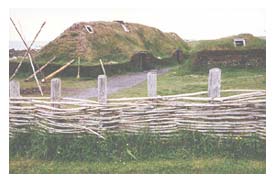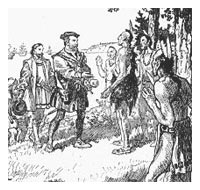 |
| Arrival of the
Europeans |
Europeans land in Canada
The earliest discovery of the New World was made by Norse seafarers
known as Vikings. The vague accounts of their exploits are drawn
from their sagas, epic stories in prose or verse handed down
by word of mouth through many generations.
In AD 985 Norse seamen sailing from Iceland to Greenland were
blown far westward off their course and sighted the coast of
what must have been Labrador. The report of forested areas on
the strange new coast encouraged further explorations by Norse
colonists from Greenland, whose settlements lacked lumber. In
AD 1000 Leif Ericson became the first European to land in North
America (see Ericson). According to the sagas, this was the
first of many Norse voyages to the eastern shores of the continent.

Viking settlement near
L'Anse-aux-Meadows, Newfoundland (reconstruction)
|
A colony was established in what the Vikings described as Vinland,
identified in 1963 as being on the northernmost tip of Newfoundland.
Recent investigations have cast doubt on the once-popular theory
that the Vikings also penetrated Hudson Bay and reached the
upper Great Lakes region by overland routes. Discoveries of
"Norse" relics in that area have been exposed by scholars as
hoaxes. The Greenland colony died out during the 14th and 15th
centuries, and the Norse adventures in Canada must have come
to an end well before that time.
Rediscovery and Exploration
In 1497 an Italian named John Cabot sailed west from Bristol,
England, intent on finding a new trade route to the Orient for
his patron, King Henry VII of England. This voyage led to the
rediscovery of the eastern shores of Canada. Cabot was as confident
as Columbus had been that a new seaway was now open to Asia.
On a second voyage, the following year, Cabot explored the coast
of North America, touching at various points--none too clearly
charted--from Baffin Island to Maryland. The Cabot voyages gave
England a claim by right of discovery to an indefinite area
of eastern North America. Its later claims to Newfoundland,
Cape Breton Island, and neighboring regions were at least partly
based on Cabot's exploits.
Of more immediate significance were the explorer's reports of
immensely rich fishing waters. The Roman Catholic countries
of Western Europe furnished a market that made the ocean voyage
worthwhile, even if it were made to gather the harvest of the
sea instead of the spices and jewels of the Orient.
Almost every year after 1497 an international mixture of fishing
vessels could be seen on the offshore fisheries southeast of
Newfoundland and east of Nova Scotia. Occasionally such ships
even cruised into the Gulf of St. Lawrence. At times their crews
encountered Indians along the shores who were willing to part
with valuable furs in exchange for articles of little worth
such as beads and other trinkets. When it was realized that
only the wilds of an unexplored new world had been discovered,
there was a spirit of disillusionment in Europe. Gradually,
however, this feeling was replaced by a fresh interest in North
America, for Spanish and Portuguese adventurers were reported
to be bringing home rich cargoes of gold and silver from the
Caribbean.
In 1524 King Francis I of France sent a Florentine navigator,
Giovanni da Verrazano, on a voyage of reconnaissance overseas.
Verrazano explored the eastern coastline of North America from
North Carolina to Newfoundland, giving France too some claim
to the continent by right of discovery.

Jacques Cartiers meets
the Iroquois |
Cartier's Explorations
Ten years later Francis I followed up the work of Verrazano
by dispatching an expedition under Jacques Cartier. On his voyage
of 1534 Cartier sailed a route that was for the most part already
well known. This was an official exploring expedition, however,
and its immediate result was a thorough report for the French
king about the lands he had seen and the people he had met.
He visited and named most of the important coasts on the Gulf
of St. Lawrence and oberved near Anticosti Island that he might
be in the mouth of a great river.
The first known penetration of the interior through the St.
Lawrence River gateway took place the following year, when Cartier
returned as leader of a new expedition. Pressing upstream in
three small vessels, he reached the Indian village of Stadacona,
near the present site of the city of Quebec. A little more than
150 miles farther upstream he reached the end of navigation
at a large island in the river. Here he found another Indian
village, called Hochelaga, on the site of the present city of
Montreal. From the height behind it, to which he gave the name
Mont Real, he could see the foaming Lachine Rapids blocking
the way to the upper waters of the St. Lawrence. At Stadacona,
Cartier and his followers passed a bitter winter. Many of his
party died from cold and scurvy before he could set sail for
France the following spring.
End of the First Colonizing
Effort
In 1541 Cartier led his third, and probably his last, expedition
to the St. Lawrence. A new headquarters was established at Cap-Rouge,
a few miles upstream from Stadacona. This time Cartier was to
be followed by Jean Francois de la Rocque, sieur de Roberval,
with a party of colonists. After a wait which lasted through
the following winter, Cartier set sail for home, only to meet
Roberval's party "in three tall ships" in the harbor of what
is now St. John's, Newf. Disregarding the orders of Roberval,
who was his senior officer, to accompany the colonizing party
back to Quebec, Cartier sailed for France under cover of darkness.
The Roberval expedition proceeded upstream, and a tragically
unsuccessful effort was made to found a permanent colony on
the site where Cartier had wintered the previous season. By
the following year some 60 of the colonists had died. Roberval
decided to abandon the whole colonizing project, and France
itself turned its back on the Canadian experiment for almost
60 years.
|
|